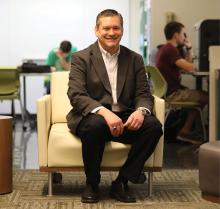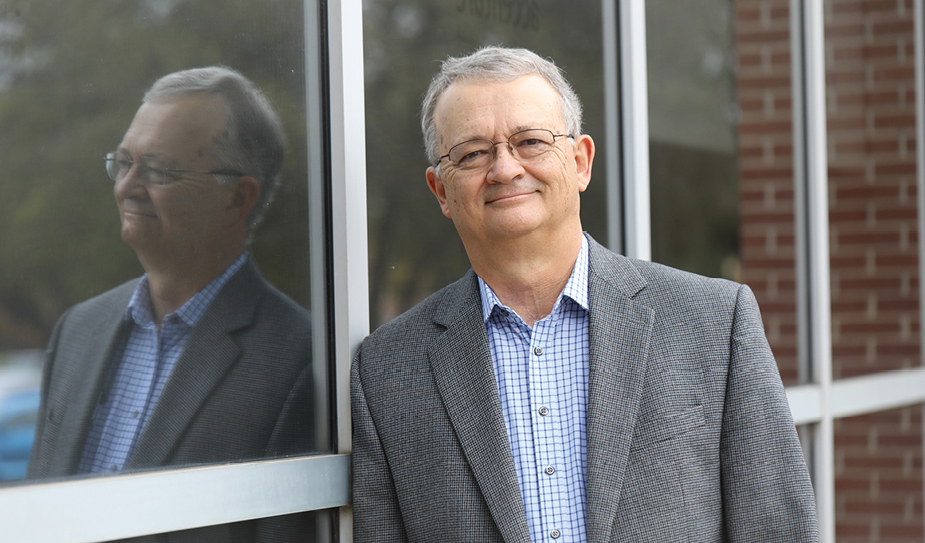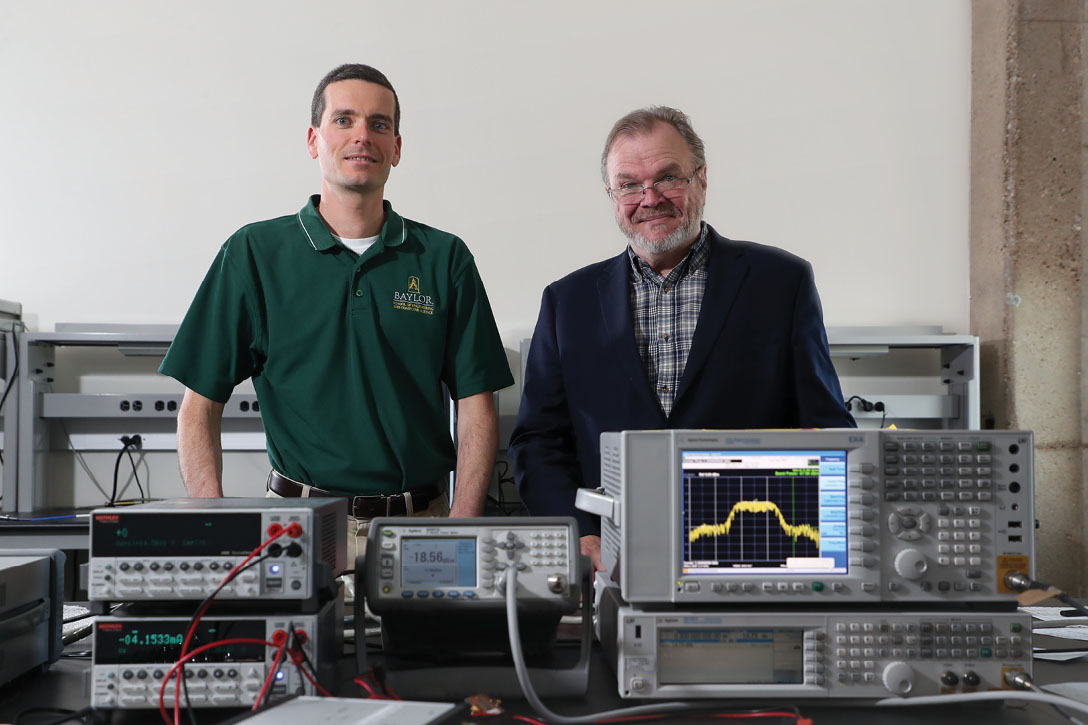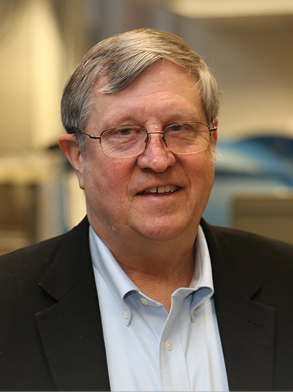Researching For The Sky
Top-flight faculty pioneer research poised to make dramatic improvements in the aerospace industry for generations to come.
Before Wilbur and Orville Wright succeeded in flying the first manned, controlled, power-driven, heavier-than-air aircraft in North Carolina’s Outer Banks back in 1903, the brothers had conducted extensive research on the concepts of how things fly with the goal of designing and building a working airplane. They studied the successes and failures of other experimenters, read books on aeronautics, corresponded with engineers, and transferred knowledge that they had acquired from working on printing presses and bicycles in their shops and by building kites. They also devoted a significant amount of time observing birds in flight, which ultimately helped them understand and apply the technique of roll control by warping a portion of an airplane wing. After all, in the words of Wilbur Wright, “It is possible to fly without motors, but not without knowledge and skill.”
Now more than a century later from that epic first flight, researchers continue to look skyward to advance our knowledge of aviation. And here at Baylor, aviation history is still being made as several faculty members and students in the School of Engineering & Computer Science (ECS) take part in pivotal research to dramatically improve a wide range of issues in the aviation industry, from icing on wings and turbines and composite materials for jets to radar, gas turbines and quiet propellers—to positively impact safety, performance efficiencies, cost effectiveness and more.
Sky-High Research
Dr. Stephen McClain, associate professor of mechanical engineering, is among those Baylor faculty members whose research is helping to forge the future in the world of aviation. “I came to Baylor in August of 2007. The Christian mission of the University as well as the commitment to excellence in both engineering research and education were primary reasons I wanted to come to Baylor,” he says.
Today, Dr. McClain is making meaningful contributions to that Christian mission through his research and teaching. Currently, he is engaged in three externally sponsored projects directly related to the aviation industry, and in all of those projects, collaboration with fellow faculty and students is key.
One of Dr. McClain’s research projects is a National Aeronautics and Space Administration (NASA) collaborative agreement focusing on airframe in-flight icing physics. “The specific issue of interest is measuring and modeling roughness on aircraft surfaces that forms during the early stages of ice accretion events and quantifying how the ice roughness affects the energy transfer from the water to the airstream,” says Dr. McClain. “This research is intended to improve ice accretion codes developed by NASA that will be used by U.S. manufacturers in the design of future-generation aircraft.”
Another project, funded by a Federal Aviation Administration (FAA) grant, is a collaborative endeavor with Dr. Dennis O’Neal, dean of ECS, that focuses on developing models that describe the frost accumulation and frost roughness evolution when an aircraft sits at an airport with full wing fuel tanks following a flight. “The project is intended to provide reference information for the FAA to enable evaluation of certification exemption requests from aircraft manufacturers for take-off with frost contaminated wings,” notes Dr. McClain.
Dr. McClain is also working on a privately sponsored venture with the project’s lead researcher Dr. Randall Jean, professor of electrical and computer engineering. The research involves developing microwave technologies to detect ice inside the compressors of turbofan jet engines. “The effort is intended to provide pilots with early warnings of high-altitude, ice-crystal icing events long before an engine power roll-back or flame-out occurs,” Dr. McClain explains.
For his exceptional work in aircraft icing research, Dr. McClain has been elected an Associate Fellow for the American Institute of Aeronautics and Astronautics (AIAA), an honor recognizing individuals “who have accomplished or been in charge of important engineering or scientific work, or who have done original work of outstanding
merit, or who have otherwise made outstanding contributions to the arts, sciences, or technology of aeronautics or astronautics,” as defined by the AIAA. He is just one of 134 Associate Fellows being inducted in 2018.
Also with the potential to impact the aviation industry is a Department of Energy/National Energy Technology Laboratory project through Pennsylvania State University that Dr. McClain is working on in partnership with Dr. Lesley Wright, associate professor of mechanical engineering. The research deals with design methodologies for additively manufactured gas turbine components that impact roughness.
“Gas turbine engines are the engine of choice for most aircraft,” says Dr. Wright, whose work mostly focuses on research related to gas turbine cooling technology. “Increasing the temperature of the air within the engine increases the amount of power the engine can produce. Due to the extreme temperatures and mechanical stresses seen in these engines, most components are made of metal. These components must be actively cooled so that they can withstand the rising temperatures within the hot section of the engine.”
Dr. Wright and Dr. McClain have worked with the government as well as engine manufacturers to develop new cooling technology for both the combustion and turbine sections of the engine. “Increasing the maximum temperature within the engine allows for more power production while maintaining/reducing the overall weight of the engine,” Dr. Wright explains. “Increasing the thrust-to-weight ratio of the engine increases the overall performance of the aircraft.”
Adds Dr. McClain, “While this project focuses primarily on land-based turbines for power generation, these technologies may eventually make it into aviation gas-turbine engines.”
So how does Dr. McClain hope that the outcomes of his research will impact the aviation industry? “My ultimate aviation goals for the research are the same as for any engineering project: make the products safer, more energy efficient, and more cost effective,” he says. “The three projects that are directly aviation industry-related are safety issues. Airframe icing, cold-soaked fuel frost on wings and engine icing are all serious safety concerns for the aviation industry. As the physics of each situation are better understood, the objective is to enable designs that are safe while meeting the weight and fuel consumption requirements of future-generation aircraft.”
While Dr. McClain has conducted much of his research in the Rogers Engineering and Computer Science Building, including work using the Baylor Subsonic Wind Tunnel, he is beginning to migrate his equipment—such as the Liquid Film and Cloud Tunnel, a new, smaller wind tunnel—to set up shop in the Baylor Research and Innovation Collaborative (BRIC). Just five years old, the 300,000-square-foot BRIC, which serves as the cornerstone of a 21-acre discovery park that will evolve into the Central Texas Technology and Research Park, has helped put Baylor on the academic map as a nationally ranked research institution replete with state-of-the-art spaces for research centers, wet and dry labs, workforce training, academic symposia and more.
Having ideal spaces conducive to conducting top-notch research is one thing, but it’s the Baylor community of faculty, students, administrators and other partners that makes the most difference, of course. “In addition to being capital assets for research, the facilities are significant in recruiting good students and new faculty members,” says Dr. McClain. “Baylor cultivates highly talented students with excellent work ethics. I would not be able to work on the projects I have today without the past and current students who have worked so hard in my lab. Further, I have incredibly gifted colleagues who are called to their work and who are passionate about both engineering research and education.”
On a Wing and a Prayer
Dr. Randall Jean was called to his work, indeed, when one Sunday morning in 2002 he opened an electrical engineering magazine before church and happened upon a job posting for a faculty position in Baylor’s ECS. “I wasn’t looking for a job when I opened up a magazine to the page of the Baylor ad and read the words ‘active Christian mission.’ It was as if God walked into the room, and I knew without question at that minute that I’d be joining Baylor. I even told my wife that morning that we were moving to Waco.”
Some nine months later, Dr. Jean and his family did just that. But before joining the ranks as a Baylor faculty member, Dr. Jean began his research at Texas A&M University, where he developed an interest in microwave-applied metrology as a doctoral student and conducted research at the Remote Sensing Center to build upon NASA studies involving the use of metrology in the lunar program. After serving on the faculty of Texas A&M for eight years, he left academia to run his own startup technology company specializing in microwave sensors for about 17 years. With a wealth of experience in both the
academic and business worlds, Dr. Jean brings indispensable insight and guidance into the lab, the field and the classroom, where undergraduate, master’s and doctoral students work alongside dedicated faculty members in their research.
In fact, it was thanks to the entrepreneurial spirit of one industrious student, Chris Faulkner (BSECE ’12, MSECE ’14), that ECS received a donation of a $90,000 Pratt & Whitney jet engine. “We were in need of a turbine engine for our research. Chris went in search of an engine at the Waco airport and asked the local company, Blackhawk Modifications, if they had a suitable engine. Blackhawk had received an ideal engine just that day and graciously agreed to donate it to Baylor.”
Baylor students have also been instrumental in Dr. Jean’s research being conducted along with Dr. McClain. “Dr. McClain was talking about his research, and the question arose: can you measure ice in jet engines?” says Dr. Jean. “[From there,] we started conversations with people at NASA and others in the aviation industry and convinced investors that we could measure it.”
Part of that process requires building a working prototype, and having the modern, well-equipped facilities of the BRIC to create such technology cannot be underestimated, adds Dr. Jean. “I’ve been in the BRIC since 2013, and it’s fantastic! When you bring potential sponsors into the BRIC, they have to take you seriously.”
Investment and proof of concept are also part and parcel in the process of earning patents, of course. “The patent process is expensive and arduous. It can often take up to five years or more,” notes Dr. Jean.
Nevertheless, earning a patent represents the highest level of excellence in your research. Dr. Jean holds more than a dozen U.S. patents (and corresponding foreign patents) in the field of microwave-applied metrology, and soon may earn another as Baylor has applied for a patent for the jet engine technology. [Dr. Jean will take a leave of absence this year and will hand the research baton to his former doctoral student, Dr. Brandon Herrera (BSECE ’08, MSECE ’11, PhD ECE ‘15), who will be heading up his microwave research.]
The Right Stuff
Working with such enterprises as L-3 Communications, Birkeland Current, Delta-G Aerospace, Sandia National Laboratories and Oak Ridge National Laboratory, Dr. David Jack, associate professor of mechanical engineering, is also immersed in crucial research with real-world impact in several industries—among them: the aerospace industry. In fact, his work using ultrasound technology—a nondestructive testing method—to reveal the structure of composite materials, such as that used in the wing of an airplane—has led to the first patent application originating from work in the Materials Characterization Laboratory at the BRIC, and a number of other related patents are under way.
Dr. Jack’s research centers on the analysis and design procedures that effectively and efficiently represent the relationship between the processing conditions and product performance for composites fabricated from a broad spectrum of engineering inclusions. His work, which ranges from nano- to macro-levels, involves industrial applications that include everything from niche military aerospace multifunctional aircraft panels to large-volume, low-price automotive components. Far from merely being an academic endeavor, the work involves useable technology that’s critical for quality control of manufactured parts, which, of course, is critical when it comes not only to operating and cost efficiencies but also to safety—for example, by predicting the likelihood of accidents.
More than a dozen Baylor undergraduate and graduate students have worked alongside Dr. Jack in the lab in multidisciplinary research, including on projects that require a high level of mathematics. Pursuing research in a Christian environment for a “bigger purpose” is also important to Dr. Jack, who was attracted to Baylor because of its Christian mission and commitment to teaching the next generation of Christian leaders in their chosen vocations. “I had been taught in school [that] your religion and your career are separate, but at Baylor, I learned it was not the case,” says Dr. Jack, who joined Baylor in 2009. “You don’t have to disconnect your faith and your vocation; they are intricately tied together. You are one person, not two separate people.”
On the Radar
A member of the Baylor faculty since 2008, Dr. Charles Baylis, associate professor of electrical and computer engineering, is also mentoring the next generation of Christian leaders in the classroom and the lab with research opportunities in RF/microwave amplifier and oscillator design; biological applications of RF/microwave measurements; and transistor modeling and related measurement techniques.
Dr. Baylis, working alongside Baylor colleague Dr. Robert Marks, distinguished professor of electrical and computer engineering, as well as professors from Purdue University and the U.S. Army Research Laboratory (ARL) scientists and engineers, is currently engaged in a Collaborative Alliance (CA) to develop next-generation radar hardware. Building from Dr. Baylis and Dr. Marks’s research with their colleagues in the Wireless and Microwave Circuits and Systems labs in the BRIC developing algorithms for advanced radar systems with a grant from the National Sciences Foundation, the researchers’ scientific pursuits coincide with work being conducted at the Adelphi Laboratory Center (ALC) in Adelphi, Maryland. The CA is infusing more than $850,000 in funding into the research, providing invaluable opportunities for Baylor undergraduate and graduate student researchers in the BRIC and at the ALC.
“Unlike conventional radar, next-generation radar transmitters coexist with wireless communication devices using the same airwaves and can adjust themselves on the fly and allow for adaptation to battlefield conditions,” says Dr. Baylis, who also serves as the director of the Wireless and Microwave Circuits and Systems Program at Baylor. “Most importantly, next-generation radar will assist American warriors who sacrificially put themselves in harm’s way on our behalf.” The developments for future radar systems are expected to go into operation around 2030.
The Sky’s the Limit
While Baylor’s reputation for world-renowned research continues to grow, it may be hard to imagine that research wasn’t always part of the fabric of academic life within ECS. Just ask Dr. Kenneth Van Treuren, associate dean of research and faculty development and professor of mechanical engineering, who is also currently serving as the interim department chair.
After retiring from a successful 21-year career as a pilot in the United States Air Force (USAF), which included teaching cadets at the USAF Academy in aeronautics, Dr. Van Treuren joined the Baylor faculty in 1998—not for the research opportunities but, rather, for the University’s Christian stewardship and excellence in scholarship. “I saw the environment at Baylor—the small class sizes, the excellent students and the Christian mission—and was impressed; it was a calling to come here,” says Dr. Van Treuren.
In fact, when Dr. Van Treuren first arrived on campus, faculty weren’t required to conduct research. In the span of his 20-year tenure at Baylor, however, he has witnessed ECS’s meteoric rise to include more master’s programs, the introduction of doctoral programs, new hi-tech lab spaces, increased funding sources and, of course, the addition of highly esteemed faculty active in vital research. Today, Baylor ranks as a “university with high research activity,” as deemed by the Carnegie Classification of Institutions of Higher Education, and in line with the University’s Pro Futuris vision, ECS is moving full speed ahead to help the University reach its aspiration of international recognition as a “Carnegie-classified Research University with very high research activity.”
But despite the dramatic changes at ECS—and Baylor—through the years, one aspect has never changed: the Christian mission, says Dr. Van Treuren. “The growth of ECS has been amazing, and our engineering programs are tremendous. In particular, mechanical engineering nationwide has grown tremendously; the versatility of the mechanical engineering degree exposes students to many different topics and opens a lot of doors,” he says. “Of course, you can go to any of 40-plus universities in Texas for an engineering degree, so why come to Baylor? Because of our Christian mission and heritage. We offer outstanding engineering programs in the context of Christian principles. That’s who we are. We help make [students’ education] meaningful and prepare them to face the world.”
Another constant is that the area of aviation has always been popular among students within the School, observes Dr. Van Treuren, who brings his treasure-trove of insights and experience as a veteran Air Force pilot into the classroom and the lab, adding a dimension to learning that can’t be garnered from a textbook.
Currently, Dr. Van Treuren is working on three projects and has had as many as 10 students participating in the research process at any given time. He and his team have already achieved remarkable levels of success on a project for the United States Air Force in which they’re designing new propellers for unmanned aerial systems to make them more efficient and quieter than the currently used stock propeller. They are also working to design and optimize a small wind turbine that will work well in places, such as Waco, that aren’t ideal for wind turbines. Further, they are researching low-pressure turbine flow separation in jet engines, a problem that is compounded when flying at high altitudes; by studying the physics of how flow separation happens, they are learning how to fix the problem and, as a result, design engines that operate more efficiently.
Conducting research helps both students and faculty stay sharp and up to date with cutting-edge technology and innovative ideas, adds Dr. Van Treuren. “Hands-on experience through labs helps students learn better. Research informs what they’re learning in the classroom,” he says. “Also, the more our students get outside the building and present papers at conferences, it’s a win-win situation for everyone. Students gain the experience and confidence concerning their research. Baylor gains some prestige because when our students
go out the door, they’re an extension of us, and they reflect very
well on Baylor.”
And just as the Wright Brothers altered the course of history through ingenuity, hard work, perseverance and determination, so, too, are Baylor researchers and students as they navigate the uncharted skies of the aerospace industry, an industry ripe with virtually endless research possibilities. For as the French proverb goes, “There is no flying without wings.”



